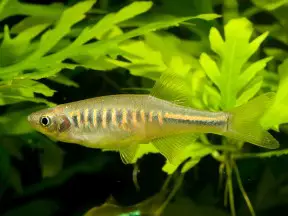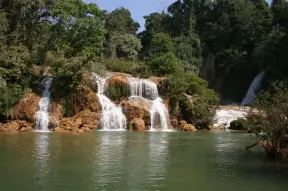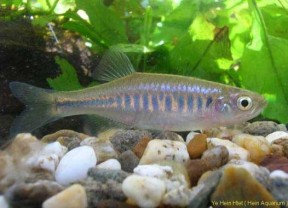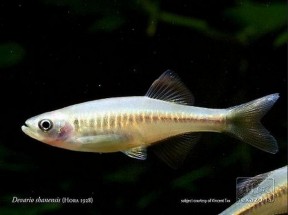'Inlecypris' shanensis
SynonymsTop ↑
Danio shanensis Hora, 1928; Devario shanensis (Hora, 1928); Brachydanio shanensis (Hora, 1928)
Etymology
Inlecypris: from Inle, referring to Inlé Lake, Myanmar, to which the type species is endemic, and Cypris, a common suffix for cyprinid genera.
shanensis: named for the northern Shan states (now unified as Shan state) in northern Myanmar.
Classification
Order: Cypriniformes Family: Cyprinidae
Distribution
Known from the Duthawadi and Salween river systems in Shan state, northeastern Myanmar although the full extent of its range remains somewhat unclear.
Type locality is ‘Hsipaw, northern Shan States, Myanmar’, Hsipaw being a town located on the Duthawadi.
Habitat
Has been collected from fast-flowing streams containing clear water with substrates of rocks, pebbles and sand.
Sympatric fish species include Brachydanio rosea, Opsarius barnoides, and Pethia stoliczkana, plus unidentified members of Schistura, Physoschistura and Lepidocephalichthys.
Maximum Standard Length
50 – 60 mm.
Aquarium SizeTop ↑
An aquarium with surface dimensions of 80 ∗ 30 cm or similar should be the smallest considered.
Maintenance
Thrives in an aquarium set up to resemble a flowing stream or river with a substrate of variably-sized, water-worn rocks, sand, fine gravel and perhaps some small boulders.
This can be further furnished with driftwood roots or branches, and while the majority of aquatic plants will fail to thrive in such surroundings hardy types such as Microsorum, Bolbitis or Anubias spp. can be grown attached to the décor.
Since it naturally occurs in pristine habitats it’s probably intolerant to accumulation of organic pollutants and requires more-or-less spotless water in order to thrive.
Though very fast flow is unnecessary it should also prefer a relatively high proportion of dissolved oxygen and moderate water movement.
Weekly water changes of 30-50% volume should be considered routine, and the tank must have a very tightly-fitting cover as all Devario spp. are accomplished jumpers.
Water Conditions
Temperature: 18 – 26 °C
pH: 6.0 – 8.0
Hardness: 36 – 268 ppm
Diet
Almost certain to prey chiefly on insects and their larvae in nature although in the aquarium it’s a largely unfussy feeder and will accept most foods.
A good quality dried product can be used as the staple diet but this should be supplemented with regular meals of small live and frozen fare such as chironomid larvae (bloodworm), Daphnia, Artemia, etc., for the best colouration and conditioning.
Behaviour and CompatibilityTop ↑
A peaceful species suited to a well-chosen community aquarium.
There are plenty of potential tankmates including many cyprinids, loaches, cichlids, catfishes and characins, although as always proper research is essential in order to avoid problems.
It is a schooling species by nature and ideally should be kept in a group of at least 8-10 specimens which will not only make the fish less nervous but will result in a more effective, natural looking display.
Any aggression will also be contained as the fish concentrate on maintaining their hierarchical position within the group, and males tend to display better colours in the presence of rivals.
Sexual Dimorphism
Sexually mature females are normally deeper-bodied, less colourful and grow a little larger than males.
Nuptial males intensify in colour, especially when reproductively active.
Reproduction
An egg-scattering free spawner exhibiting no parental care.
When in good condition they will spawn often and in a well-planted, mature aquarium it’s possible that small numbers of fry may start to appear without intervention.
However if you want to maximise yield a more controlled approach is required.
The adult group can still be conditioned together but a smaller tank should also be set up and filled with mature water.
This should be very dimly lit and the base covered with some kind of mesh of a large enough grade so that the eggs can fall through but small enough so that the adults cannot reach them. The widely available plastic ‘grass’-type matting can also be used and works well, as does a layer of glass marbles.
Alternatively filling much of the tank with a fine-leaved plant such as Taxiphyllum spp. or wool mops can also return decent results.
The water itself should be of slightly acidic to neutral pH with a temperature towards the upper end of the range suggested above, and an air-powered sponge filter or air stone(s) should also be included to provide oxygenation and water movement.
When the adults are well-conditioned and the females appear gravid one or two pairs should then be introduced.
If ready spawning usually taking place within 24 hours, with the female tending to appear noticeably slimmer after the event, and after 48 hours the adults should be removed whether this is observed or not.
Incubation is temperature-dependant to an extent but typically lasts 24-36 hours with the young free-swimming a few days later.
Initial food should be Paramecium or similar, introducing Artemia nauplii, microworm, powdered dry foods, etc., once the fry are large enough to accept them.
NotesTop ↑
This species is sometimes referred to as ‘Hora danio’ or Salween danio’.
It is distinguished from similar-looking species by a combination of characters as follows: lateral line complete or incomplete with 22-33 pored scales; absence of infraorbital process; 7 branched dorsal-fin rays; usually 10 or 11 branched anal-fin rays; barbels absent or rudimentary; flank markings comprising a series of narrow vertical bars on the anterior portion of each flank, followed by a horizontal P stripe (see below for definition) extending to the caudal peduncle base; P stripe itself not broken into a series of blotches.
It is most easily confused with ‘I.‘ maetaengensis and Devario interruptus, but in ‘I.‘ maetaengensis the lateral line has 31-35 pored scales, both rostral and maxillary barbels are present, and the P stripe (see description below) is comprised of a series of contiguous blotches.
In D. interruptus the lateral line is incomplete with 7-17 pored scales, barbels are completely absent, and the flank markings comprise a series of short, relatively wide and equally deep vertical bars/blotches which are slightly wider than the P stripe, while the P stripe consists of a row of contiguous dark blotches and terminates at the caudal-fin base.
In recent years it’s become commonplace to refer to the stripes on the body and fins of danionins as follows:
– P stripe: or ‘pigment stripe’ is the central, dark, lateral stripe on the body which extends into the caudal-fin in some species. Stripes above it are numbered P+1, P+2, etc., and those beneath P-1, P-2, P-3.
– A stripe: the central stripe on the anal-fin; the proximal stripe (above it) is A+1 and the distal stripe (beneath) A-1.
– D stripe: The submarginal dorsal-fin stripe.
The type species of the genus Inlecypris, I. auropurpurea, was originally described as a member of Barilius (Annandale, 1918) but Howes (1980a) considered it more closely related to cheline cyprinids (Chela and Laubuca spp.) based on morphological characters and erected the genus Inlecypris for it (Howes, 1980b).
Fang (2003) supported Howes’ conclusions in her 2003 phylogenetic study of the genus Danio, hypothesising that Inlecypris and Chela together form a sister group to Devario.
In a more recent phylogenetic work by Fang et al. (2009) I. auropurpurea was found to be most closely-related to the similarly-patterned Devario maetaengensis and D. shanensis, thus rendering Devario paraphyletic.
Inlecypris was therefore synonymised with Devario, a decision ratified by Tang et al. (2010), but this was reversed by Kottelat (2013) on the basis that Inlecypris species are very distinct in terms of appearance. In doing so, he noted that phylogenetic evidence suggest the existence of two genetic lineages within Devario. The first contains the species with prominent lateral stripes, which leaves the remaining members of uncertain taxonomic placement. Two of the latter grouping are currently referred to as ‘Inlecypris‘ maetaengensis and ‘I.‘ shanensis, respectively, in order to retain monophyly of Inlecypris, but will probably be moved into a separate genus at a later date, where they may be joined by Devario apogon and D. chrysotaeniatus.
References
- Cottle, P. W., 2010 - NPM Publishing: 1-160
Danios and Devarios. - Fang, F., 1997 - Ichthyological Exploration of Freshwaters 8(1): 41-48
Danio maetaengensis, a new species of cyprinid fish from northern Thailand. - Fang, F., 2000 - Ichthyological Research 47(1): 13-26
Barred Danio species from the Irrawaddy River drainage (Teleostei, Cyprinidae). - Fang, F., 2003 - Copeia 2003(4): 714-728
Phylogenetic Analysis of the Asian Cyprinid Genus Danio (Teleostei, Cyprinidae). - Fang, F., M. Norén, T. Y. Liao, M. Källersjö and S. O. Kullander, 2009 - Zoologica Scripta 38(1): 1-20
Molecular phylogenetic interrelationships of the south Asian cyprinid genera Danio, Devario and Microrasbora (Teleostei, Cyprinidae, Danioninae). - Kottelat, M., 2013 - Raffles Bulletin of Zoology Supplement 27: 1-663
The fishes of the inland waters of southeast Asia: a catalogue and core bibiography of the fishes known to occur in freshwaters, mangroves and estuaries. - Mayden, R. L., K. L. Tang, K. W. Conway, J. Freyhof, S. Chamberlain, M. Haskins, L. Schneider, M. Sudkamp, R. M. Wood, M. Agnew, A. Bufalino, Z. Sulaiman, M. Miya, K. Saitoh, S. He, 2007 - Journal of Experimental Zoology, Molecular Development and Evolution 308B: 642-654
Phylogenetic relationships of Danio within the order Cypriniformes: a framework for comparative and evolutionary studies of a model species. - Pramod, P. K., F. Fang, K. Rema Devi, T.-Y. Liao, T. J. Indra, K. S. Jameela Beevi and S. O. Kullander, 2010 - Zootaxa 2519: 31-47
Betadevario ramachandrani a new danionine genus and species from the Western Ghats of India (Teleostei: Cyprinidae: Danioninae). - Tang, K. L., M. K. Agnew, W. J. Chen., M. V. Hirt, T. Sado, L. M. Schneider, J. Freyhof, Z. Sulaiman, E. Swartz, C. Vidthayanon, M. Miya, K. Saitoh, A. M. Simons, R. M. Wood and R. L. Mayden, 2010 - Molecular Phylogenetics and Evolution 57(1): 189-214
Systematics of the subfamily Danioninae (Teleostei: Cypriniformes: Cyprinidae).





